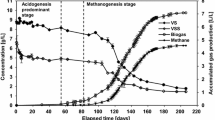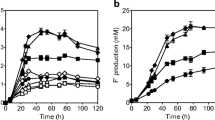Summary
Model studies of anaerobic protein digestion were performed using gelatin dissolved in a mineral medium, which was fed to a mixed population of bacteria in a carbon-substrate limited chemostat culture. The dilution rate and culture pH value were varied progressively in order to determine the optimal conditions for hydrolysis and acidification (i.e., fatty acids formation). The optimum pH value appeared to be in the neutral region (pH>6.3), and the maximal dilution rate allowing steady state growth was 0.23 h-1. At this dilution rate and at pH 7 hydrolysis of gelatin was 78% complete, and 79% of the protein hydrolysed was fermented to identifiable products. At submaximal dilution rates both these values were higher. The main fermentation products were acetate, propionate, and valerate, and minor amounts of other volatile fatty acids. The product composition was relatively independent of the dilution rate, but varied substantially with the pH value.
Similar content being viewed by others
References
Assche PF van (1982) Microbial aspects of anaerobic digestion. Antonie van Leeuwenhoek 48:420
Buchanan RE, Gibbons NE (1975) Bergey's Manual of determinative bacteriology, 8th ed. Williams and Wilkins Co., Baltimore, USA
Cohen A, Zoetemeyer RJ, Deursen A van, Andel JG van (1979) Anaerobic digestion of glucose with separated acid production and methane formation. Water Res 13:571–580
Cohen A, Breure AM, Andel JG van, Deursen A van (1980) Influence of phase separation on the anaerobic digestion of glucose. I: Maximum COD-turnover rate during continuous operation. Water Res 14:1439–1448
Cohen A, Breure AM, Andel JG van, Deursen A van (1982a) Influence of phase separation on the anaerobic digestion of glucose. II: Stability and kinetic responses to shock loadings. Water Res 16:449–455
Cohen A, Deursen A van, Andel JG van, Breure AM (1982b) Intermediates and degradation patterns in anaerobic digestion of glucose; experiments with 14C-labeled substrates. Antonie van Leeuwenhoek 48:337–352
Elsden SR, Hilton MG, Walter JM (1976) The end products of the metabolism of aromatic amino acids by Clostridia. Arch Microbiol 107:283–288
Elsden SR, Hilton MG (1978) Volatile acid production from threonine, valine, leucine and isoleucine by Clostridia. Arch Microbiol 117:165–172
Evans CGT, Herbert D, Tempest DW (1970) The continuous cultivation of microorganisms. 2 Construction of a chemostat. In: Norris JR, Ribbons DW (eds) Methods in microbiology, vol II. AP, London, pp 277–327
Herbert D, Phipps PJ, Strange RE (1971) Chemical analysis of microbial cells. In: Norris JR, Ribbons DW (eds) Methods in microbiology, vol VB. AP, London, pp 209–344
Lettinga G, Velsen AFM van, Hobma SW, Zeeuw W de, Klapwijk A (1980) Use of the upflow sludge blanket (USB) reactor concept for biological wastewater treatment, especially for anaerobic treatment. Biotechnol Bioeng 22:699–734
Levisohn S, Aronson AI (1967) Regulation of extra-cellular protease production in Bacillus cereus. J Bacteriol 93:1023–1030
McInerney MJ, Bryant MP, Hespell RB, Costerton JW (1981) Syntrophomonas wolfei gen. nov. sp. nov. an anaerobic syntrophic, fatty acid-oxidizing bacterium. Appl Environ Microbiol 41:826–828
Nagase M, Matsuo T (1982) Interactions between amino acid degrading bacteria and methanogenic bacteria in anaerobic digestion. Biotechnol Bioeng 24:2227–2239
Nisman B (1954) The stickland reaction. Bacteriol Rev 18:16–48
Pette KC, Vletter R de, Wind E, Gils W van (1980) Full-scale anaerobic treatment of beetsugar waste water. Proc 35th Ind Waste Conf Purdue Univ, pp 635–642
Pipyn A, Verstraete W (1981) Lactate and ethanol as intermediates on two-phase anaerobic digestion. Biotechnol Bioeng 23:1145–1154
Siebert ML, Toerien DF (1969) The proteolytic bacteria present in the anaerobic digestion of raw sewage sludge. Water Res 3:241–250
Stahl E (1962) Aminosäure und Derivate. In: Dünnschicht-Chromatographie. Springer, Berlin, pp 407–421
Tetlow JA, Wilson AL (1964) An absorbtiometric method for determining ammonia in boiler-feed water. Analyst 89:453–465
Zoetemeyer RJ, Arnoldy P, Cohen A, Boelhouwer C (1982a) Influence of temperature on the anaerobic acidification of glucose in a mixed culture forming part of a two-stage digestion process. Water Res 16:313–321
Zoetemeyer RJ, Heuvel JC van den, Cohen A (1982b) pH influence on acidogenic dissimilation of glucose in an anaerobic digestor. Water Res 16:303–311
Zoetemeyer RJ, Matthijsen AJCM, Heuvel JC van den, Cohen A, Boelhouwer C (1982c) Anaerobic digestion of glucose in an upflow reactor. Biomass 2:187–199
Author information
Authors and Affiliations
Rights and permissions
About this article
Cite this article
Breure, A.M., van Andel, J.G. Hydrolysis and acidogenic fermentation of a protein, gelatin, in an anaerobic continuous culture. Appl Microbiol Biotechnol 20, 40–45 (1984). https://doi.org/10.1007/BF00254644
Received:
Issue Date:
DOI: https://doi.org/10.1007/BF00254644




